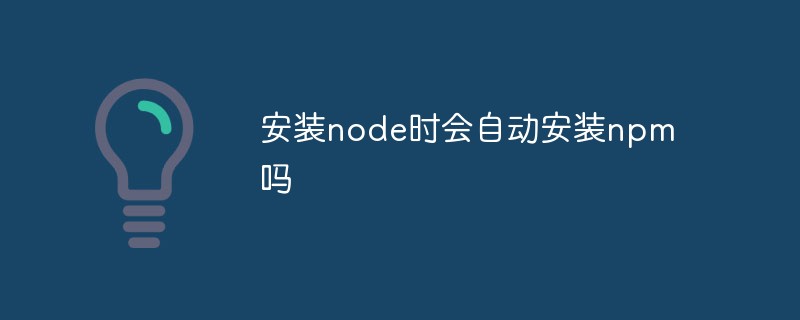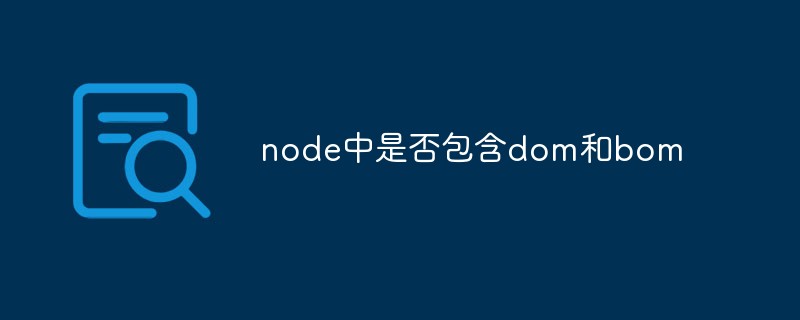 Web Front-end
Web Front-end JS Tutorial
JS Tutorial Let's talk in depth about how to use the Node process management tool-pm2
Let's talk in depth about how to use the Node process management tool-pm2How to use the Node process management tool-pm2. The following article will talk about how to use the Node process management tool-pm2. I hope it will be helpful to you!

What is pm2
pm2 is a daemon process management tool that can help you protect and manage your applications. Usually pm2 is used for management when the service goes online. There are actually many things that pm2 can do, such as monitoring file changes and automatically restarting, unified management of multiple processes, built-in load balancing, logging system, etc. Let us take a look at how to use pm2
pm2 Basic commands
First we create a simple node service, create a new folder and executenpm init, then install pm2
npm i pm2 -g
Create new index.js and index2.js, Write two simple http services, and then use pm2 to manage them. [Related tutorial recommendations: nodejs video tutorial, Programming teaching]
//index.js
let http = require("http");
let server = http.createServer();
server.on("request", function (req, res) {
console.log("------------------enter");
res.write("hello juejin");
res.end();
});
server.listen(3000, function () {
console.log(`服务器启动成功,通过http://localhost:3000/进行访问`);
});//index2.js
let http = require("http");
let server = http.createServer();
server.on("request", function (req, res) {
console.log("------------------enter2");
res.write("hello juejin2");
res.end();
});
server.listen(3001, function () {
console.log(`服务器启动成功,通过http://localhost:3001/进行访问`);
});Next we will use the first command of pm2: pm2 start index. js and pm2 start index2.js Start these two programs respectively

Of course, if you want to specify the process name, you can do this: pm2 start -n test index.js, if you want to monitor file changes, you can add --watch and so on
Visit http://localhost:3000/

Execute pm2 logYou can see the log we printed

pm2 There are many more commands, here are a few
- Stop 1/multiple/all programs
pm2 stop id/id1 id2 id3/all - Kill Dead 1/multiple/all programs
pm2 delete id/id1 id2 id3/all - Restart 1/multiple/all programs
pm2 restart id/id1 id2 id3/ all - Start and view the log
pm2 start api.js --attach - List the application
pm2 list - View monitoring panel
pm2 monit - View program data
pm2 show [id]
Load balancing
We all know that NodeJS is an asynchronous single-threaded language. If it is deployed directly to the server without any processing, then it can only use one thread of the server, which is a huge waste of performance.
Using pm2 only requires one command to allow our program to make full use of the server's CPU. Take index.js as an example: pm2 start index -i max, for example, my computer is 10 If the core is 20 threads, it will open 20 threads

#Of course, if you want to specify how many threads you want, you can directly change max to the number of threads you want to openpm2 start index -i 3

Configuration file
We all used the command line to manage the above examples, which is actually quite inconvenient. Fortunately, pm2 provides the form of configuration files.
We directly use the command pm2 init simple to generate a simple configuration file ecosystem.config.js, modify it to point to our two services
module.exports = {
apps: [
{
name: "index",
script: "./index.js",
},
{
name: "index2",
script: "./index2.js",
},
],
};Then we kill all the original processes and execute pm2 start ecosystem.config.js. Similarly, our two services are started

The following are some configuration itemsecosystem.config.js
module.exports = {
apps: [
{
name: "index", //name
script: "./index.js", //相对于pm2 start 的相对路径
cwd: "", //要启动的应用程序的目录
instances: 2, //要启动实例的数量,就是上面提到的负载
watch: true, //是否启动监听
env: { NODE_ENV: "development" }, // 将出现在您的应用程序中的 env 变量
env_xxx: {
NODE_ENV: "xxx", //使用pm2注入xxx变量进行切换
},
log_date_format: "YYYY-MM-DD HH:mm Z", //日志时间格式
error_file: "./log/index-error.log", //错误文件路径
out_file: "./log/index-out.log", //输出日志文件路径
max_restarts: 10, //最大重启数
restart_delay: 4000, //重启延迟时间ms
autorestart: true, //是否自动重启
cron_restart: "", //定时重启 使用cron表达式
},
{
name: "index2",
script: "./index2.js",
},
],
};Log
The log is very important for back-end troubleshooting, pm2 automatically With log function, for example, we configured the log-related parameters in the above configuration file
log_date_format: "YYYY-MM-DD HH:mm Z", //日志时间格式 error_file: "./log/index-error.log", //错误文件路径 out_file: "./log/index-out.log", //输出日志文件路径
When we start the project, the log will be recorded under the log

The logging function that comes with pm2 does not support log splitting. As time goes by, the log files will become larger and larger, which will not only affect performance, but also be very troublesome to troubleshoot later, so we need to split the logs. The log splitting operation is very simple. You only need to install the pm2-logrotate plug-in. Note that here is pm2 install
pm2 install pm2-logrotate
and then execute pm2 conf to see the relevant configuration

Explain the relevant meaning
Compress:是否通过 gzip 压缩日志
max_size:单个日志文件的大小
retain:保留的日志文件个数
dateFormat:日志文件名中的日期格式,默认是 YYYY-MM-DD_HH-mm-ss
rotateModule:是否把 pm2 本身的日志也进行分割,
workerInterval:检查文件时间间隔
rotateInterval:设置强制分割,默认值是 0 0 * * *,意思是每天晚上 0 点分割,这里使用的是 corn 表达式,不会的可以搜索一下
如果我们想要配置也很简单,比如修改 max_size
pm2 set pm2-logrotate:max_size 1K
然后我们简单测试一下这个工具,我们先设置每个 log 文件最大 1kb
然后重启我们的项目
pm2 restart ecosystem.config.js
然后就会发现我们的日志被分割了

总结
pm2对于node服务的管理是十分方便的,文中提到的只是其中一部分,如果你想使用pm2管理你的服务的话可以到官网pm2.io/ 进行学习
更多node相关知识,请访问:nodejs 教程!
The above is the detailed content of Let's talk in depth about how to use the Node process management tool-pm2. For more information, please follow other related articles on the PHP Chinese website!
 node、nvm与npm有什么区别Jul 04, 2022 pm 04:24 PM
node、nvm与npm有什么区别Jul 04, 2022 pm 04:24 PMnode、nvm与npm的区别:1、nodejs是项目开发时所需要的代码库,nvm是nodejs版本管理工具,npm是nodejs包管理工具;2、nodejs能够使得javascript能够脱离浏览器运行,nvm能够管理nodejs和npm的版本,npm能够管理nodejs的第三方插件。
 Vercel是什么?怎么部署Node服务?May 07, 2022 pm 09:34 PM
Vercel是什么?怎么部署Node服务?May 07, 2022 pm 09:34 PMVercel是什么?本篇文章带大家了解一下Vercel,并介绍一下在Vercel中部署 Node 服务的方法,希望对大家有所帮助!
 node爬取数据实例:聊聊怎么抓取小说章节May 02, 2022 am 10:00 AM
node爬取数据实例:聊聊怎么抓取小说章节May 02, 2022 am 10:00 AMnode怎么爬取数据?下面本篇文章给大家分享一个node爬虫实例,聊聊利用node抓取小说章节的方法,希望对大家有所帮助!
 node导出模块有哪两种方式Apr 22, 2022 pm 02:57 PM
node导出模块有哪两种方式Apr 22, 2022 pm 02:57 PMnode导出模块的两种方式:1、利用exports,该方法可以通过添加属性的方式导出,并且可以导出多个成员;2、利用“module.exports”,该方法可以直接通过为“module.exports”赋值的方式导出模块,只能导出单个成员。
 安装node时会自动安装npm吗Apr 27, 2022 pm 03:51 PM
安装node时会自动安装npm吗Apr 27, 2022 pm 03:51 PM安装node时会自动安装npm;npm是nodejs平台默认的包管理工具,新版本的nodejs已经集成了npm,所以npm会随同nodejs一起安装,安装完成后可以利用“npm -v”命令查看是否安装成功。
 node中是否包含dom和bomJul 06, 2022 am 10:19 AM
node中是否包含dom和bomJul 06, 2022 am 10:19 AMnode中没有包含dom和bom;bom是指浏览器对象模型,bom是指文档对象模型,而node中采用ecmascript进行编码,并且没有浏览器也没有文档,是JavaScript运行在后端的环境平台,因此node中没有包含dom和bom。
 聊聊Node.js path模块中的常用工具函数Jun 08, 2022 pm 05:37 PM
聊聊Node.js path模块中的常用工具函数Jun 08, 2022 pm 05:37 PM本篇文章带大家聊聊Node.js中的path模块,介绍一下path的常见使用场景、执行机制,以及常用工具函数,希望对大家有所帮助!


Hot AI Tools

Undresser.AI Undress
AI-powered app for creating realistic nude photos

AI Clothes Remover
Online AI tool for removing clothes from photos.

Undress AI Tool
Undress images for free

Clothoff.io
AI clothes remover

AI Hentai Generator
Generate AI Hentai for free.

Hot Article

Hot Tools

Zend Studio 13.0.1
Powerful PHP integrated development environment

SublimeText3 English version
Recommended: Win version, supports code prompts!

Dreamweaver Mac version
Visual web development tools

ZendStudio 13.5.1 Mac
Powerful PHP integrated development environment

Dreamweaver CS6
Visual web development tools






